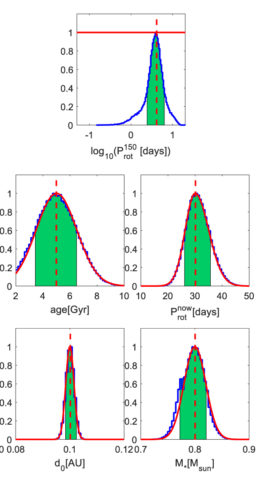Can we use clues from the present to figure out how a planet has been blasted by the radiation of its host star in the past? According to a new study, it’s a definite possibility.
A History of Rotation and Radiation

Three example rotation-period curves show that stars can start with very different rotation rates and evolutionary tracks, but after 2 billion years, the tracks all converge. [Kubyshkina et al. 2019]
How can we tell how much flux a star has historically emitted? This is tricky! We know that stars that rotate faster produce more high-energy radiation. But though stars are born with vastly different spin rates, they all lose angular momentum and spin down over time.
For a while, all these spin-down tracks are unique. But after about 2 billion years of slowing down, the tracks for stellar rotation evolution converge — if you’re looking at a star older than 2 billion years, you can no longer directly tell from its current properties how fast it rotated in the past, or how much flux it consequently emitted over its history.
But if a star has a sub-Neptune-sized planet in a close orbit? According to a new study led by Daria Kubyshkina (Austrian Academy of Sciences), we might then be able to make some inferences!
Clues from a Modern Atmosphere
For stars hosting close-in planets with hydrogen-dominated atmospheres, a bit of creative modeling of a planet’s atmospheric evolution can allow us to infer its host’s flux evolution history.

Recovery of an injected signal in the authors’ analysis. In this example, the mass of the planet is assumed to be exactly known. The posterior distributions for the other parameters of the system (blue curves) well match the prior distributions of the input parameters (red curves). From top to bottom, the parameters are the stellar rotation period at 150 Myr, age of the system and present-time rotation period, and orbital separation and stellar mass. [Adapted from Kubyshkina et al. 2019]
Hunting Down Masses
This framework has applications beyond just understanding the past rotation and radiation of the host star.
Say we observe a system containing multiple planets; here one planet mass is well known, but the others are not. Under the authors’ analysis, the mass of the first planet can be used to place strong constraints on the rotation history of the star. But this history can then be used in conjunction with the observed radii for the system’s other planets to obtain realistic estimates for their masses!
The authors show the power of this analysis by applying it to two known planetary systems, HD 3167 and K2-32, inferring the rotation history of the two stars and constraining the masses of the planets in the systems. Their work clearly demonstrates the importance of advances in theory and modeling to help us get the most out of our growing body of exoplanet observations.
Citation
“Close-in Sub-Neptunes Reveal the Past Rotation History of Their Host Stars: Atmospheric Evolution of Planets in the HD 3167 and K2-32 Planetary Systems,” D. Kubyshkina et al 2019 ApJ 879 26. doi:10.3847/1538-4357/ab1e42
